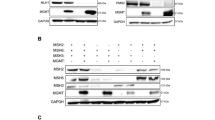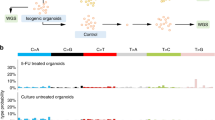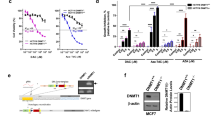Abstract
Recent findings suggest that DNA alkylating agents trigger cellular responses that overlap those activated after ionizing radiation. Moreover, activation of these responses is dependent upon a functional mismatch repair (MMR) system. These developments led us to test if MMR-deficient cells may be compromised in their ability to activate appropriate cellular signaling pathways after ionizing radiation. An initial experiment to address this notion was to determine the level of radiosensitivity of several MMR-deficient cell lines derived from patients with Hereditary Non-Polyposis Colorectal Cancer (HNPCC). While two of the three HNPCC lines investigated show levels of radiosensitivity consistent with that displayed by normal human fibroblasts, HCT-116 cells display moderate radiosensitivity compared to the other MMR-deficient lines. This increased sensitivity to ionizing radiation correlates with lowered levels of ATM expression in HCT-116. Analysis of genomic DNA from HCT-116 cells determined that these cells possess aberrant methylation of multiple CpG dinucleotides within the proximal promoter region of the ATM gene. The significance of this finding is underscored by our observations that co-culturing HCT-116 cells with the DNA demethylating agent 5-azacytidine reverses promoter methylation, promotes normal levels of ATM expression, and restores normal radiosensitivity. The proximal ATM promoter is a ∼520 bp region shared with the NPAT gene, and current evidence suggests that this region functions as a bi-directional promoter. We found that, unlike ATM, the methylation status of this intergenic region does not effect the expression of the NPAT gene. In sum, these observations indicate that the ATM gene is a novel target for epigentic silencing through inappropriate methylation of its proximal promoter region.
This is a preview of subscription content, access via your institution
Access options
Subscribe to this journal
Receive 50 print issues and online access
$259.00 per year
only $5.18 per issue
Buy this article
- Purchase on Springer Link
- Instant access to full article PDF
Prices may be subject to local taxes which are calculated during checkout





Similar content being viewed by others
References
Athma P, Rappaport R, Swift M . 1996 Cancer Genet. Cytogenet. 92: 130–134
Barlow C, Hirotsune S, Paylor R, Liyanage M, Eckhaus M, Collins F, Shiloh Y, Crawley JN, Reid T, Tagle D, Wynshaw-Boris A . 1996 Cell 86: 159–171
Barlow C, Ribaut-Barassin C, Zwingman TA, Pope AJ, Brown KD, Owens JW, Larson D, Harringtion EA, Haeberle AM, Mariani J, Eckhaus M, Herrup K, Bailly Y, Wynshaw-Boris A . 2000 Proc. Natl. Acad. Sci. USA 97: 871–876
Baylin SB, Belinsky SA, Herman JG . 2000 J. Natl. Cancer Inst. 92: 1460–1461
Bigbee WL, Langlois RG, Swift M, Jensen RH . 1989 Am. J. Hum. Genet. 44: 402–408
Bird A . 1992 Cell 70: 5–8
Brown KD, Barlow C, Wynshaw-Boris A . 1999 Am. J. Hum. Genet. 64: 46–50
Brown KD, Coulson RMR, Yen TJ, Cleveland DW . 1994 J. Cell Biol. 125: 1303–1312
Brown KD, Lataxes T, Kumar S, Mannino JL, Giardina J, Chen J, Baskaran R . 2000 J. Biol. Chem. 275: 6651–6656
Byrd PJ, Cooper PR, Stankovic T, Kullar HS, Watts GD, Robinson PJ, Taylor MR . 1996 Hum. Mol. Genet. 5: 1785–1791
Chen PC, Lavin MF, Kidson C, Moss D . 1978 Nature 274: 484–486
Chen X, Yang L, Udar N, Liang T, Uhrhammer N, Xu S, Bay JO, Wang Z, Dandakar S, Chiplunkar S, Klisak I, Telatar M, Yang H, Concannon P, Gatti RA . 1997 Mamm. Genome 8: 129–133
Costello JF, Berger MS, Huang HS, Cavenee WK . 1996 Cancer Res. 56: 2405–2410
Dork T, Bendix R, Bremer M, Rades D, Klopper K, Nicke M, Skawran B, Hector A, Yamini P, Steinmann D, Weise S, Stuhrmann M, Karstens JH . 2001 Cancer Res. 61: 7608–7615
Duckett DR, Bronstein SM, Taya Y, Modrich P . 1999 Proc. Natl. Acad. Sci. USA 96: 12384–12388
Ejima Y, Yang L, Sasaki MS . 2000 Int. J. Cancer 86: 262–268
Esteller M, Silva JM, Dominguez G, Bonilla F, Matias-Guiu X, Lerma E, Bussaglia E, Prat J, Harkes IC, Repasky EA, Gabrielson E, Schutte M, Baylin SB, Herman JG . 2000 J. Natl. Cancer Inst. 92: 564–569
Fearon ER, Vogelstein B . 1990 Cell 61: 759–767
Fritzell JA, Narayanan L, Baker SM, Bronner CE, Andrew SE, Prolla TA, Bradley A, Jirik FR, Liskay RM, Glazer PM . 1997 Cancer Res. 57: 5143–5147
Gatti RA, Tward A, Concannon P . 1999 Mol. Genet. Metab. 68: 419–423
Gnarra JR . 1998 J. Natl. Cancer Inst. 90: 1685–1687
Herman JG, Baylin SB . 2000 Curr. Top. Microbiol. Immunol. 249: 35–54
Herman JG, Latif F, Weng Y, Lerman MI, Zbar B, Liu S, Samid D, Duan DS, Gnarra JR, Linehan WM, Baylin SB . 1994 Proc. Natl. Acad. Sci. USA 91: 9700–9704
Herman JG, Umar A, Polyak K, Graff JR, Ahuja N, Issa JP, Markowitz S, Willson JK, Hamilton SR, Kinzler KW, Kane MF, Kolodner RD, Vogelstein B, Kunkel TA, Baylin SB . 1998 Proc. Natl. Acad. Sci. USA 95: 6870–6875
Hickman MJ, Samson LD . 1999 Proc. Natl. Acad. Sci. USA 96: 10764–10769
Hiraguri S, Godfrey T, Nakamura H, Graff J, Collins C, Shayesteh L, Doggett N, Johnson K, Wheelock M, Herman J, Baylin S, Pinkel D, Gray J . 1998 Cancer Res. 58: 1972–1977
Imai T, Yamauchi M, Seki N, Sugawara T, Saito T, Matsuda Y, Ito H, Nagase T, Nomura N, Hori T . 1996 Genome Res. 6: 439–447
Kane MF, Loda M, Gaida GM, Lipman J, Mishra R, Goldman H, Jessup JM, Kolodner R . 1997 Cancer Res. 57: 808–811
Kastan MB, Lim DS . 2000 Nat. Rev. Mol. Cell Biol. 1: 179–186
Khanna KK . 2000 J. Natl. Cancer Inst. 92: 795–802
Kinzler KW, Vogelstein B . 1996 Cell 87: 159–170
Knudson Jr AG . 1971 Proc. Natl. Acad. Sci. USA 68: 820–823
Lengauer C, Kinzler KW, Vogelstein B . 1997 Proc. Natl. Acad. Sci. USA 94: 2545–2550
Ma T, Van Tine BA, Wei Y, Garrett MD, Nelson D, Adams PD, Wang J, Qin J, Chow LT, Harper JW . 2000 Genes Dev. 14: 2298–2313
Morrell D, Cromartie E, Swift M . 1986 J. Natl. Cancer Inst. 77: 89–92
Nowell PC . 1976 Science 194: 23–28
Pandita TK, Hittelman WN . 1994 Mutat. Res. 310: 1–13
Rotman G, Shiloh Y . 1998 Hum. Mol. Genet. 7: 1555–1563
Savitsky K, Bar-Shira A, Gilad S, Rotman G, Ziv Y, Vanagaite L, Tagle DA, Smith S, Uziel T, Sfez S, Ashkenazi M, Pecker I, Frydman M, Harnik R, Patanjali SR, Simmons A, Clines GA, Sarteil A, Gatti RA, Chessa L, Sanal O, Lavin MF, Jaspers NGJ, Taylor AMR, Arlett CF, Miki T, Weissman SM, Lovett M, Collins FS, Shiloh Y . 1995 Science 268: 1749–1753
Swift M, Reitnauer PJ, Morrell D, Chase CL . 1987 N. Engl. J. Med. 316: 1289–1294
Taylor AM, Metcalfe JA, Thick J, Mak YF . 1996 Blood 87: 423–438
Teraoka SN, Malone KE, Doody DR, Suter NM, Ostrander EA, Daling JR, Concannon P . 2001 Cancer 92: 479–487
Toyota M, Ahuja N, Ohe-Toyota M, Herman JG, Baylin SB, Issa JP . 1999 Proc. Natl. Acad. Sci. USA 96: 8681–8686
Veigl ML, Kasturi L, Olechnowicz J, Ma AH, Lutterbaugh JD, Periyasamy S, Li GM, Drummond J, Modrich PL, Sedwick WD, Markowitz SD . 1998 Proc. Natl. Acad. Sci. USA 95: 8698–8702
Xu Y . 1999 Adv. Immunol. 72: 179–189
Yan T, Schupp JE, Hwang HS, Wagner MW, Berry SE, Strickfaden S, Veigl ML, Sedwick WD, Boothman DA, Kinsella TJ . 2001 Cancer Res. 61: 8290–8297
Zhao J, Dynlacht B, Imai T, Hori T, Harlow W . 1998 Genes Dev. 12: 456–461
Ziv Y, Bar-Shira A, Pecker I, Russell P, Jorgensen TJ, Tsarfati I, Shiloh Y . 1997 Oncogene 15: 159–167
Acknowledgements
We thank Dr Bryan Gebhardt (Department of Ophthamology, LSUHSC) for allowing us access to the 137Cs irradiator, Dr Timothy Jorgensen (Georgetown University) for advice in conducting radiosensitivity analyses, and Dr Wade Harper (Baylor College of Medicine) for his generous gift of anti-NPAT antisera. This work was supported by a research project grant (RPG) from the American Cancer Society (GMC-98564), and a grant from the Louisiana Board of Regents Health Excellence Fund.
Author information
Authors and Affiliations
Corresponding author
Rights and permissions
About this article
Cite this article
Kim, Wj., Vo, Q., Shrivastav, M. et al. Aberrant methylation of the ATM promoter correlates with increased radiosensitivity in a human colorectal tumor cell line. Oncogene 21, 3864–3871 (2002). https://doi.org/10.1038/sj.onc.1205485
Received:
Revised:
Accepted:
Published:
Issue Date:
DOI: https://doi.org/10.1038/sj.onc.1205485
Keywords
This article is cited by
-
ATM-deficient lung, prostate and pancreatic cancer cells are acutely sensitive to the combination of olaparib and the ATR inhibitor AZD6738
Genome Instability & Disease (2020)
-
Aberrantly methylated-differentially expressed genes and pathways in colorectal cancer
Cancer Cell International (2017)
-
Identification of aberrant DNA methylation involved in chemoradiation-resistant HCT116 cells via methylation-specific microarray
Molecular & Cellular Toxicology (2016)
-
Sodium glycididazole enhances the radiosensitivity of laryngeal cancer cells through downregulation of ATM signaling pathway
Tumor Biology (2016)
-
Review of the development of DNA methylation as a marker of response to neoadjuvant therapy and outcomes in rectal cancer
Clinical Epigenetics (2015)



